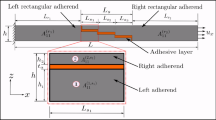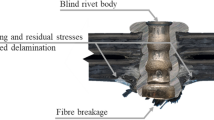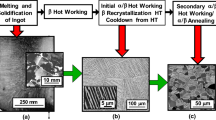Abstract
An approach to estimate interface shear stress of ceramic matrix composites during fatigue loading has been developed in this paper. By adopting a shear-lag model which includes the matrix shear deformation in the bonded region and friction in the debonded region, the matrix crack space and interface debonding length are obtained by matrix statistical cracking model and fracture mechanics interface debonding criterion. Based on the damage mechanisms of fiber sliding relative to matrix in the interface debonded region upon unloading and subsequent reloading, the unloading counter slip length and reloading new slip length are determined by the fracture mechanics method. The hysteresis loops of four different cases have been derived. The hysteresis loss energy for the strain energy lost per volume during corresponding cycle is formulated in terms of interface shear stress. By comparing the experimental hysteresis loss energy with computational values, the interface shear stress corresponding to different cycles can then be derived. The theoretical results have been compared with experimental data of three different ceramic composites.














Similar content being viewed by others
References
Naslain, R.: Design, preparation and properties of non-oxide CMCs for application in engines and nuclear reactors: an overview. Compos. Sci. Technol. 64, 155–170 (2004). doi:10.1016/S0266-3538(03)00230-6
Ji, F.S., Dharani, L.R.:Non-axisymmetric matrix cracking and interface debonding with friction in ceramic composites. Appl. Compos. Mater. 5, 379–397 (1998). doi:10.1023/A:1008820315282
Curtin, W.A.: Stress-strain behavior of brittle matrix composites. Comprehensive composite materials, Elsevier Science Ltd. 4, 47–76 (2000). doi:10.1016/B0-08-042993-9/00088-7
Rouby, D., Reynaud, P.: Fatigue behavior related to interface modification during load cycling in ceramic-matrix fiber composites. Comps. Sci. Technol. 48, 109–118 (1993). doi:10.1016/0266-3538(93)90126-2
Chen, Y.H., Shi, Z.F.: An investigation of interfacial fatigue in fiber reinforced composites. Appl. Compos. Mater. 12, 265–276 (2005). doi:10.1007/s10443-004-4556-3
Evans, A.G., Zok, F.W., McMeeking, R.M.: Fatigue of ceramic matrix composites. Acta Metall. Mater. 43, 859–875 (1995). doi:10.1016/0956-7151(94)00304-Z
Zhu, S., Mizuno, M., Kagawa, Y.: Mutoh, Y.:Monotonic tension, fatigue and creep behavior of SiC-fiber-reinforced SiC-matrix composites: a review. Compos. Sci. Technol. 59, 833–851 (1999). doi:10.1016/S0266-3538(99)00014-7
Brandstetter, J., Kromp, K., Peterlik, H., Weiss, R.: Effect of surface roughness on friction in fiber-bundle pull-out tests. Compos. Sci. Technol. 65, 981–988 (2005). doi:10.1016/j.compscitech.2004.11.004
Kuntz, M., Grathwahl, G.: Advanced evaluation of push-in data for the assessment of fiber reinforced ceramic matrix composites. Adv. Eng. Mater. 3, 371–379 (2001). doi:10.1002/1527-2648(200106)3:6<371::AID-ADEM371>3.0.CO;2-Y
Chandra, N., Ghonem, H.: Interfacial mechanics of push-out tests: theory and experiments. Composites-Part A. Appl. Sci. Manuf. 32, 575–584 (2001). doi:10.1016/S1359-835X(00)00051-8
Reynaud, P.: Cyclic fatigue of ceramic-matrix composites at ambient and elevated temperatures. Compos. Sci. Technol. 56, 809–814 (1996). doi:10.1016/0266-3538(96)00025-5
Mei, H., Cheng, L.F.: Comparison of the mechanical hysteresis of carbon/ceramic-matrix composites with different fiber performs. Carbon 47, 1034–42 (2009). doi:10.1016/j.carbon.2008.12.025
Kotil, T., Holmes, J.W., Comninou, M.: Origin of hysteresis observed during fatigue of ceramic matrix composites. J. Am. Ceram. Soc. 73, 1879–1883 (1990). doi:10.1111/j.1151-2916.1990.tb05239.x
Pryce, A.W., Smith, P.A.: Matrix cracking in unidirectional ceramic matrix composites under quasi-static and cyclic loading. Acta Metall mater. 41, 1269–1281 (1993). doi:10.1016/0956-7151(93)90178-U
Keith, W.P., Kedward, K.T.: The stress-strain behavior of a porous unidirectional ceramic matrix composites. Compos. 26, 163–174 (1995). doi:10.1016/0010-4361(95)91379-J
Ahn, B.K., Curtin, W.A.: Strain and hysteresis by stochastic matrix cracking in ceramic matrix composites. J. Mech. Phys. Solids. 45, 177–209 (1997). doi:10.1016/S0022-5096(96)00081-6
Li, L.B., Song, Y.D., Sun, Z.G.: Influence of interface de-bonding on the fatigue hysteresis loops of ceramic matrix composites. Chinese. J. Solid. Mech. 30, 8–14 (2009)
Li, L.B., Song, Y.D., Sun, Z.G.: Effect of fiber Poisson contraction on fatigue hysteresis loops of ceramic matrix composites. J. Nanjing. Uni. Aero. Astron. 41, 181–6 (2009)
Yang, B., Mall, S.: Cohesive-shear-lag model for cycling stress-strain behavior of unidirectional ceramic matrix composites. Int. J. Damage. Mech. 12, 45–64 (2003). doi:10.1177/1056789503012001003
Fantozzi, G., Reynaud, P.: Mechanical hysteresis in ceramic matrix composites. Mater. Sci. Eng-Part A. Struct. (2009). doi:10.1016/jmsea.2008.09.128
Solti, J. P., Robertson, D. D., Mall, S.: Estimation of interfacial properties from hysteretic energy loss in unidirectional ceramix matrix composites. Adv. Comp. Mater. 9, 161–173 (2000)
Budiansky, B., Hutchinson, J.W., Evans, A.G.: Matrix fracture in fiber-reinforced ceramics. J. Mech. Phys. Solids. 34, 167–189 (1986). doi:0022-5096/86$3.00+0.00
Curtin, W.A.: Multiple matrix cracking in brittle matrix composites. Acta Metall mater. 41, 1369–77 (1993). doi:10.1016/0956-7151(93)90246-O
Solti, J.P., Mall, S., Robertson, D.D.: Modeling damage in unidirectional ceramic matrix composites. Compos. Sci. Technol. 54, 55–66 (1995). doi:10.1016/0266-3538(95)00041-0
Gao, Y., Mai, Y., Cotterell, B.: Fracture of fiber-reinforced materials. J. Appl. Math. Phys. 39, 550–572 (1988). doi:10.1007/BF00948962
Sun, Y.J., Singh, R.N.: The generation of multiple matrix cracking and fiber-matrix interfacial debonding in a glass composite. Acta Mater. 46, 1657–1667 (1998). doi:10.1016/S1359-6454(97)00347-9
Aveston, J., Cooper, G.A., Kelly, A.: Single and multiple fracture. Properties of fiber composites: conference on proceedings, pp. 15–26. National Physical Laboratory, IPC, England (1971)
Beyerle, D.S., Spearing, S.M., Zok, F.W., Evans, A.G.: Damage and failure in unidirectional ceramic matrix composites. J. Am. Ceram. Soc. 75, 2719–25 (1992). doi:10.1111/j.1151-2916.1992.tb05495.x
Holmes, J.W., Cho, C.: Experimental observations of frictional heating in fiber-reinforced ceramics. J. Am. Ceram. Soc. 75, 929–938 (1992). doi:10.1111/j.1151-2916.1992.tb04162.x
Zawada, L.P., Butkus, L.M., Hartman, G.A.: Tensile and fatigue behavior of silicon carbide fiber-reinforced aluminosilicate glass. J. Am. Ceram. Soc. 74, 2851–2858 (1991). doi:10.1111/j.1151-2916.1991.tb06854.x
Acknowledgements
This work is sponsored by the Doctoral Innovation Foundation of Nanjing University of Aeronautics and Astronautics (No.BCXJ08-05), the Graduate Innovation Foundation of Jiangsu Province (No.CX08B-133Z).
Author information
Authors and Affiliations
Corresponding author
Rights and permissions
About this article
Cite this article
Li, L., Song, Y. An Approach to Estimate Interface Shear Stress of Ceramic Matrix Composites from Hysteresis Loops. Appl Compos Mater 17, 309–328 (2010). https://doi.org/10.1007/s10443-009-9122-6
Received:
Accepted:
Published:
Issue Date:
DOI: https://doi.org/10.1007/s10443-009-9122-6




